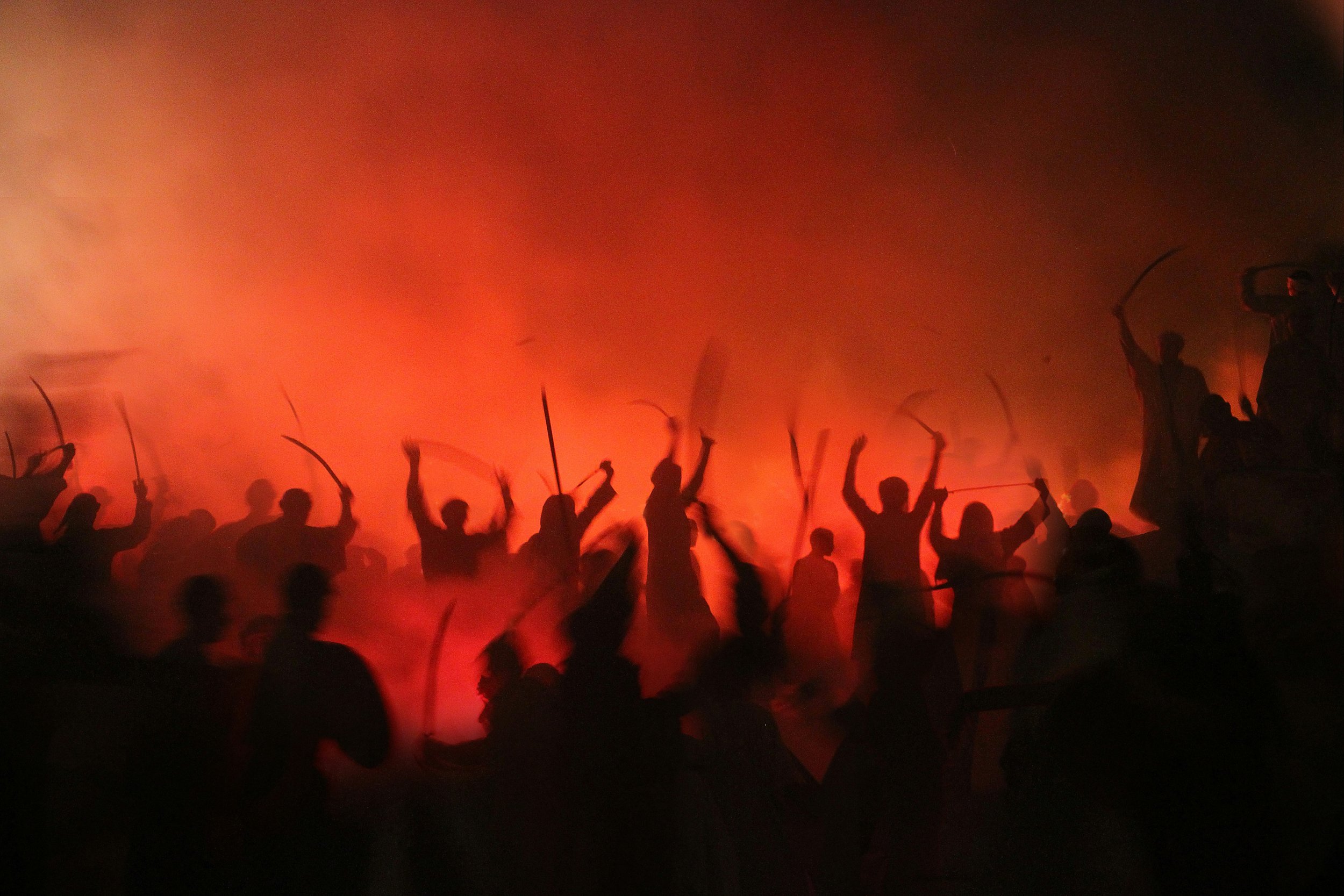What is the climax of a story? (+ tips for writing a climactic scene)
The showdown between Harry Potter and Professor Quirrell in The Philosopher’s Stone. The trial verdict in To Kill a Mockingbird. Rochester’s supernatural voice calling to Jane Eyre.
These scenes are the climax of their respective stories. They’re the culmination of plot, subplots, character arcs and conflicts throughout the rest of the novel. And they’re the point at which each book becomes un-put-downable.
Every good story builds to a climax. It’s an essential element of story structure. But why is the climax so important?
Here, we look at how, when and why you should use a climax in a story. But first, let’s start with a definition.
What is the climax of a story?
The climax is the highest point of tension in a story. It’s the part with the most drama, often characterised by a confrontation between the protagonist(s) and antagonist(s).
A climax is also a turning point. A story builds up to this climax and afterwards, a key conflict of the story is resolved.
In most murder mysteries, the climax is the point at which the detective reveals the identity of the murderer. In a romance, it can be a final crisis that the couple has to overcome in order to be together.
In the first book of Lord of the Rings, the climax comes when Boromir tries to steal the ring from Frodo in the forest. This is a turning point for Frodo. He now understands the ring’s power to corrupt and decides to continue the journey alone.
But a climax isn’t just for plot-driven books. Character-driven stories need a climax too. There should always be a point where the central conflict of the narrative is tackled and (to some extent) resolved.
In a character-driven story, this conflict can be an internal one. It can involve a decision on the part of your protagonist to live their life differently.
They might ignore their controlling mother’s phone call, overcome their fears to ask a crush out on a date or finally realise the root of their unhappiness.
Why is a climax important?
A climax is an essential part of any story. That’s because it brings all of the following to a work of fiction:
Reader excitement
The climax is an intense and exciting section in your narrative. It keeps readers engaged and propels them through the last part of your novel.
A release of tension
A climactic scene releases tension that has been steadily building throughout your story. If tension fizzles out or fails to reach a head, readers can feel deflated.
Meaning
The climax of a story resolves a central conflict. It highlights dominant themes and plays a key role in character development. A story without a satisfying climax can lack depth and meaning.
Reader satisfaction
A good climax rewards a reader’s commitment to your narrative. And – by highlighting meaning – it ensures they understand the point of your novel.
A writer’s guide
A climax gives a story direction and it gives you something to build towards. Some writers will only put pen to paper when they have a clear idea of their story’s climax.
A narrative climax has the power to make or break a story. Do it badly and readers will wonder why they devoted hours of their life to your book. Do it well and readers will turn the last page feeling satisfied with the story and excited to read more of your work.
When should the climax of a story occur?
A climax usually occurs towards the end of a story. But it can surface anywhere from the halfway point.
Just be careful not to peak too early. Once you’ve reached that crescendo, tension dissipates. And if there’s still a long way to go until the ending, readers may feel that the rest of the story drags.
When deciding where the climax in a story should occur, it can help to look at two popular narrative structures.
Freytag’s pyramid
Gustav Freytag was a 19th century German novelist. He imagined story structure as a pyramid with five distinct phases:
Exposition: setting the scene and introducing characters before an inciting incident takes place
Rising action: tension builds as a protagonist and their status quo are challenged
Climax: tension reaches a peak
Falling action: tension recedes as a new status quo is established
Denouement: the story ends, with loose plot threads and themes (to some extent) tied up
Rising action usually takes up most of the story with a climax, falling action and a denouement occurring in the last third.
The three-act structure
The three-act structure is another popular way to structure a story. It follows the age-old rule, probably taught to you in primary school, that every story needs a beginning, a middle and an end.
Act one: status quo and characters are established; an inciting incident launches us into act two
Act two: rising tension leads to a midpoint (a mini-climax) after which, the protagonist seems destined to fail
Act three: pre-climax leading up to the climax; resolution; denouement
Tips for writing the climax of a story
A lot is riding on a story climax. You need to answer burning questions, resolve conflicts and reach the right pitch of drama – all while keeping the action true to what has come before. Here are a few tips for writing the climax of a story to help you get it spot on.
Raise the stakes
A climax has to represent your protagonist’s most difficult challenge to date. In the second act of your narrative, your primary character will overcome obstacles. But nothing like this.
The best kind of story climax centres on a moment of life and death – or at least a moment that feels like life or death for your protagonist.
To raise the stakes even further, you can precede the climax of a story with a moment in which all seems lost.
Imagine a protagonist fighting the bad guys. After putting up a good fight, most of her comrades have fled or fallen and she has just one bullet left.
A final shootout under these circumstances will be even more exciting and emotional for readers because the odds are stacked against their heroine.
Take your time
When crafting a successful climax for a story, timing is everything.
We’ve already talked about when a story climax should occur. It comes after a long, strong second act, where you spend time drawing out your characters and the conflicts that drive them.
But the duration of your climactic scene also has an impact on a reader.
Remember, this is a major turning point for your protagonist so, whatever happens, it needs to feel momentous.
A climax doesn’t necessarily need to be the longest scene in your story but you should take your time, exploring the emotion and detail of what is happening. Rush a climactic scene and it will lack weight and significance.
Heighten emotion
Ideally, as your story reaches its climax, you’ll have a reader hooked. They’ll be immersed in your world and its characters – and desperate to discover what happens next. To achieve this level of reader engagement, you need to heighten emotion.
Start by following the golden rule of fiction writing: show don’t tell. Engage the senses, use dialogue and describe action rather than telling your readers what characters are thinking or feeling.
Another way to craft an intense and emotional experience for readers is by narrowing narrative distance. By keeping your readers up close to a character during your story’s climatic scene, you make them feel everything your character is going through.
Avoid “middle book syndrome”
“Middle book syndrome” is when the second story in a trilogy acts as a setup for the final instalment. It doesn’t have a clearly defined story arc in its own right.
This affects reader engagement as – without the proper structure – a middle book can feel like it’s drifting rather than driving a story forwards.
You can avoid this series-writing pitfall by ensuring every book has a compelling climax. This helps to sustain reader interest throughout each novel – and for the whole of your series.
Just remember, you’re building to a huge climatic scene in the final book. So hold something back. The climax in your first and second novels, while exciting for readers at the time, should pale in comparison to the climax that eventually comes in your last instalment.
Resolve conflict
A climax is the point at which a major conflict in your story is resolved. It’s a turning point for your story and protagonist.
Let’s look at a few examples.
In A Christmas Carol, Ebenezer Scrooge tries to ignore the impact of his greed and selfishness. But at the climax of the story, humbled by what the Ghosts of Christmas have shown him, he chooses to change his ways.
In 1984, Winston Smith struggles against the tyranny of Big Brother. But an encounter in Room 101 sees him succumb to the inhumanity of the system he lives in.
Whether your story centres on an internal conflict for your protagonist, an epic battle between good and evil or any other kind of standoff, your climax brings this conflict to a head – and then to a resolution.
Make it believable
The climax in a story should never be predictable. So surprise your readers by revealing a new piece of information, misdirecting their attention or inverting conventions.
But don’t sacrifice believability in an attempt to shock your readers or tie up loose ends. Don’t have drama for drama’s sake. Don’t drastically change the tone of your story. Readers will see the mechanics of your storytelling and feel short-changed.
So, instead, try to write a climax that fits with the foundations you’ve laid throughout the rest of the narrative.
If you’re writing a mystery, that might mean foreshadowing the detective’s big reveal with subtly placed second-act clues.
If you’re writing a character-driven story, it’ll mean making sure any character actions in the climax are consistent with their arc.
In a fantasy novel, stick to the laws and physics of the world you’ve created. Don’t introduce a new kind of magic at the eleventh hour to get your protagonist out of a sticky situation.
Avoid deus ex machina moments and be consistent with story and character to make your climax believable – and satisfying – for readers.
Change the status quo
The climax of a story is a turning point. If it’s to feel dramatic and meaningful, something significant has to change after this scene.
I’m not saying you need a neat and tidy ending. Nor do you need to give readers exactly what they’d hoped for. But you do need to demonstrate how characters, their worldview or the world itself have altered as you make your way towards an ending.
Does your story have a satisfying arc? If you’d like some help with story structure, take a look at my manuscript assessment and manuscript mentoring services. Together, we’ll hone your story to keep readers engaged from start to finish.


